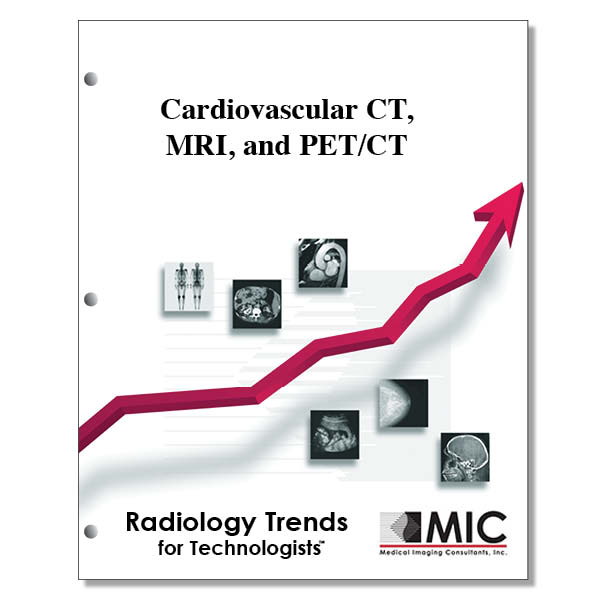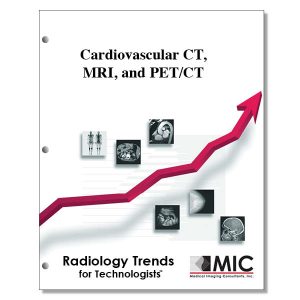

Cardiovascular CT, MRI, and PET/CT
A summary of recent, major clinical trials and the central role noninvasive cardiovascular imaging plays in individualizing diagnosis and management of heart disease.
Course ID: Q00786 Category: Radiology Trends for Technologists Modalities: Cardiac Interventional, CT, MRI, PET, RRA2.75 |
Satisfaction Guarantee |
$29.00
- Targeted CE
- Outline
- Objectivss
Targeted CE per ARRT’s Discipline, Category, and Subcategory classification:
[Note: Discipline-specific Targeted CE credits may be less than the total Category A credits approved for this course.]
Cardiac-Interventional Radiography: 0.50
Procedures: 0.50
Interventional Procedures: 0.50
Computed Tomography: 1.50
Procedures: 1.50
Neck and Chest: 1.50
Nuclear Medicine Technology: 0.50
Procedures: 0.50
Cardiac Procedures: 0.50
Registered Radiologist Assistant: 1.50
Procedures: 1.50
Thoracic Section: 1.50
Outline
- Introduction
- Coronary Artery Disease
- Severity and Extent of Coronary Artery Disease
- Ischemia versus Coronary Stenosis
- Sex Differences in Plaque Prevalence and Characteristics
- Fractional Flow Reserve CT versus Conventional Management for Stable Angina
- Structural Heart Disease
- Hypoattenuated Leaflet Thickening
- Aortic Valve and CAC Scores
- Cardiomyopathies
- Predicting Outcomes Using Cardiac MRI
- Left Ventricular Noncompaction
- Valves
- Mitral Valve Prolapse
- Severe Mitral regurgitation
- Systemic Disease
- COVID-19 Disease
- HIV Infection
- Cardiac PET/CT
- Cardiac Sarcoidosis
- Prognosis
- Bioprosthetic Valve Degenaration
- Articicial Intelligence and Machine Learning
- Statements and Guidelines
- Guidelines for the Evaluation and Diagnosis of Chest Pain
- Updated End Points for Aortic Valve Disease
- Cardiac Amyloidosis
- Multimodality Imaging and Myocardial Viability
- Frontiers in Imaging Science
- Quantification of MI
- Photon-Counting CT
- Conclusion
Objectives
Upon completion of this course, students will:
- be familiar with the primary objective of the VERDICT trial
- be familiar with the factors in defining the primary endpoint in the VERDICT trial
- be familiar with the major adverse cardiovascular events according in the CADS-RADS
- be familiar with the ISCHEMIA trial
- be familiar with the findings of the ISCHEMIA trial
- be familiar with the primary objective of the William et al study
- recognize the plaque characteristics in men versus women
- be familiar with findings of the FORECAST trial
- be familiar with the characteristic finding for subclinical leaflet thrombosis post TAVR using 4 dimensional cardiac CT
- be familiar with the incidence of hypoattenuated leaflet thickening at 30 days post-TAVR
- be familiar with the mortality rates for patients with hypoattenuated leaflet thickening
- be familiar with the end points in the study comparing aspirin versus warfarin plus aspirin after TAVR
- be familiar with the primary objective of the study conducted by Eberhard et al
- be familiar with the CAC threshold as an independent predictor of 1-month and 1-year after TAVR
- recognize how incorporating the CAC score into the EuroSCORE II impact risk stratification for patients undergoing TAVR
- be familiar with the primary focus of the PARADIGM registry
- be familiar of the need for further investigation into the association between aortic valve calcification and cardiac events
- be familiar with the guideline recommending implantable defibrillator placement in nonischemic dilated cardiomyopathies
- be familiar with the association between LGE and arrhythmic events across LVEF strata
- be familiar with the prospective, longitudinal outcomes registry involving patients with dilated cardiomyopathy
- be familiar with the “ringlike’ pattern of LGE defined in the retrospective observational study
- identify the composite outcome observed after the median follow-up regarding patients with different patterns of LGE
- be familiar with what characterizes left ventricular noncompaction (LVNC)
- be familiar with the percentage of the population affected by mitral valve prolapse
- be familiar with LGE correlation with the severity of mitral regurgitation
- be familiar with the two echocardiographic findings that may indicate possible severe mitral regurgitation
- be familiar with the cardiac MRI use in measuring regurgitant volume
- be familiar with the findings observed with mild to moderate COVID-19 disease as observed during cardiac MRI
- be familiar with the finding when evaluating patients recovering from moderate to severe COVID-19 disease pneumonia using cardiac MRI
- be familiar with the findings of 18F-NaF PET/CT in patients who underwent transcatheter aortic valve replacement
- be familiar with the decreased radiation burden related to doing CAC together with CTA
- recognize the correlation between semiautomated nonenhanced CT CAC and the deep learning algorithm from coronary CTA
- identify the functionally relevant features associated with low fractional flow reserve (FFR) per machine learning analysis
- be familiar with the calculation for myocardial salvage index in the ASSAIL-MI trial
- identify the advantage of photon-counting CT over conventional CT as indicated in Si-Mohame et al
